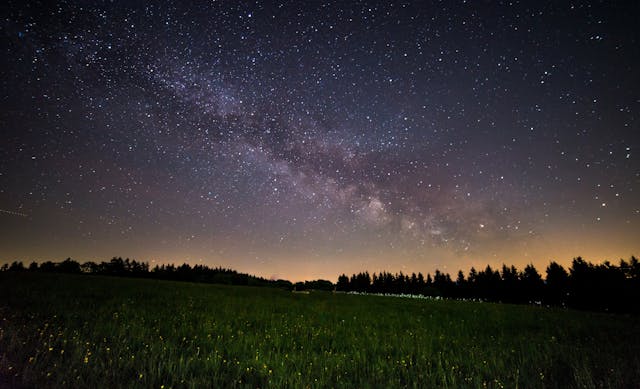
How do ultramassive black holes form? Ultramassive black holes can form when supermassive black holes collide.
To make a supermassive black hole, we need to start with a regular black hole. Black holes can form when a very large star collapses in on itself. The star has to be very large, at least 25 times larger than our star. There are many different sized stars in the universe, but they all start by fusing hydrogen atoms together into helium. This process produces energy in the form of heat and light. All stars only have a finite supply of hydrogen and once they have burned through it, the regular sized stars (such as our sun) end their lives. Once the hydrogen has gone, the core contracts and this pressure produces more heat, which starts the helium fusing into carbon. The heat pushes the outer layers of the star out and it becomes a red giant. When our sun becomes a red giant, the outer layers will reach far beyond the orbit of Earth. Once they have fused all of the helium into carbon. These stars don’t have any more fuel to burn and they shrink down to about the size of the Earth before slowly cooling down over the next several billion years. Stars that are several times bigger than the sun have a lot more gravity, which produces a lot more pressure, and they can progress past the carbon phase. All of the pressure can fuse the carbon elements together to make other heavier elements, such as oxygen, neon, silicon, magnesium, sulfur, and iron. Iron is the last element that can be made and the process stops. Iron can’t be fused because the process of fusing iron takes more energy than it produces. At this point, the star stops producing as much energy and it collapses. When stars are burning, they produce a huge amount of energy which is trying to tear the star apart, while at the same time they are so massive that they have a huge gravity which is pulling them in. The outwards force and the inwards force balance each other out. Once the star only has iron left, it doesn’t have enough heat energy to counter the gravitational force and the star collapses under its own weight. The star is compressed in seconds and the electrons and protons are fused into neutrons, making a neutron star. The intense pressure heats the star up again and it can explode in a supernova. If the original star is 25 or more times the size of our sun, the gravity is so enormous that when it cools to iron, it is squashed beyond the level of a neutron star and becomes a black hole. This is how regular black holes are formed.
How do we go from a regular black hole to a supermassive black hole? Black holes have such high gravity that they absorb material from around them. They don’t so much suck it in as they are like a drain at the bottom of the bathtub. Matter falls into them and once it is inside, it cannot get out. As the matter increases, the black hole grows bigger. As they grow, the cycle continues because bigger black holes attract more matter and consequently grow larger. The largest black holes, the supermassive black holes, are often found at the center of galaxies where matter spirals down, constantly feeding them. These supermassive black holes can be millions of times bigger than a regular black hole. It appears that most galaxies have a supermassive black hole at their center. The one at the center of the Milky Way Galaxy is called Sagittarius A and is 4 million times bigger than our sun.
How do we get from supermassive black holes to ultramassive black holes? Ultramassive black holes are much rarer than supermassive black holes and they are billions of solar masses rather than millions. If supermassive black holes continued to absorb matter, the universe has not existed for long enough for them to reach such a size. The only way for them to form is when galaxies containing supermassive black holes collide. Astronomers have recently found three of these ultramassive black holes and each one is the size of a hundred billion suns. The ultramassive black holes formed when three galaxies collided, bringing together three supermassive black holes. The resultant galaxy is three times the size of our Milky Way and the black hole at its center is enormous. It appears that these ultramassive black holes formed when the universe was much younger, possibly only 3 billion years old. The matter in the universe was relatively more concentrated than it is today and galaxies were more likely to collide with each other. Ultramassive black holes are rarer today because the distance between galaxies is too vast. However, that being said, our Milky Way is going to collide with the Andromeda Galaxy in about 4.5 billion years. If the two supermassive black holes at the centers of both galaxies come close enough to each other, they could merge and make a much larger black hole. They might need one more galaxy before they become ultramassive though. And this is what I learned today.
Photo by Pixabay: https://www.pexels.com/photo/milky-way-galaxy-433155/
Sources
https://news.uchicago.edu/explainer/black-holes-explained
https://www.stsci.edu/~marel/black_holes/encyc_mod3_q8.html
https://www.energy.gov/science/doe-explainssupernovae
https://www.stsci.edu/~marel/black_holes/encyc_mod3_q12.html
https://science.howstuffworks.com/star6.htm
https://www.skyatnightmagazine.com/space-science/black-dwarf-star
